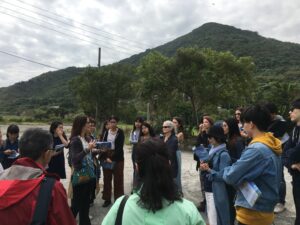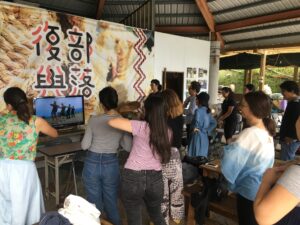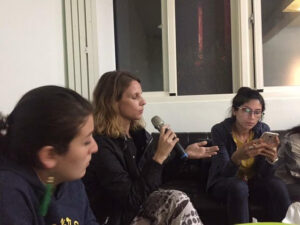Categories
Recent Posts
- Introducing SAC New Faculty Member2025 年 2 月 19 日
- 【Academic Job Vacancy】Full-Time Faculty (Tenure Track)2024 年 4 月 23 日
- Results for the 2024 International Student Admissions2024 年 5 月 22 日
- Introducing SAC New Faculty Member
Visiting the Northerners of the South
Interaction with Arts through an Indigenous Community
TNUA and IMCC graduate students travel to Eastern Taiwan to explore the unlimited features of contemporary art.

Through the outdoor installations in the public space, the common feature of the three events as they are, an increasing interest from both the governmental and private institutions in developing art and culture projects in the marginalized regions has been noticed, especially how these projects may benefit the communities in terms of prosperity, tourisms, and infrastructure, while their subtle influence on economy, education, traditional culture, ecology, population, and tribal arts is also emphasized, allowing the society to employ artistic activities to look for future possibilities.
Curator’s statement (.doc download)
Art is something you can find everywhere. It can be really close to you, but sometimes it can take you far away to explore what an indigenous community wants to tell you about their way of living. Graduate students of TNUA’s International Master of the Arts Program in Cultural and Creative Industries (IMCCI) and Fine Arts departments had the opportunity to travel to the east coast of Taiwan to appreciate the imaginative perspective of the locals to reflect their present by addressing relevant issues to their daily life. This exciting journey allowed the big group of 38 people to visit the major art festivals held in the coastal areas throughout Hualien and Taitung this year, including MIPALIW Land Art, Taiwan East Coast Land Art and The Hidden South Exhibition.
With a very busy itinerary ahead, the group guided by the professors Manray Hsu, Ya-Tin Lin, I-Wen Chang and the director of the Office of the International Affairs Jau-Lan Guo, started the trip in Hualien, which is a breathtaking place because of its natural beauty and peaceful atmosphere. It is also an indigenous land where most of the ethnic groups in Taiwan converge: Amis, Atayal, Bunun, Truku and Kebala. In addition, these tribes are well-preserved and cohabitate in a quiet harmonious environment.
One of the members of the Amis tribe, Su-Min Su, gave the group the warmest welcoming during the first stop in a former elementary school called Jiqi to visit the exhibition Under-current. The selection of artworks in this exhibition responds to the curative work of three local artists, but also includes pieces from foreign artist. Even tough Hualien is far away from Taipei, , the curators have been leading a remarkable work to interact with international artists and bring them to their communities.
The name of the exhibition takes a stand against the stereotype of “laziness”, a generalized prejudice about aboriginal people. Su-Min Su, who is also one of the curators involved in this log-term art project, disagrees with this idea; she truly believes that “you will really know that we are hard-working people once you come to stay with us and connect with us”.
Collecting art is not less hard than creating it. “We have a lot of challenges since we have to negotiate with the government to get funds to encourage this creative production, with special emphasis in local culture. However, we also want to develop a more inclusive work by integrating artists that come from abroad. Foreign artists are invited to live with us for a while aiming to ‘holistically’ understand our customs and living conditions where they will find that both work-life balance and environmental care are a must for us”, explained Su.
In fact, some of the pieces were elaborated with waste material or garbage recollected from the sea. The feminine symbolism in some other pieces was also prevalent. «KITA» an artwork made by an Indonesian artist, Arya Pandjalu, is the creation of three huge female sculptures modelled with marine waste. The artist wanted to pay tribute to the women of the Arashisaki tribe who adhere to traditional agricultural techniques and work hard to care for their families. This piece also brought an important issue to the Amis tribe: to reassure environmental care.
Contemporary art comes in a variety of forms and sizes. Sculptures made of different types of wood, fiber, metal and rocks showed the unlimited imagination of the local people to express the energy, intuition and forces that shape their identity into their creative work. Su-Min Su expressed that “a creative process is not only about art, but it is also about art in terms of life”.
Fu Hsing Tribe: No Smoke, No Alcohol, No Drugs

After having a great introduction to the efforts of the curators to mobilize creativity towards their remote communities and develop a sustainable project to promote their culture, the crew from TNUA visited an aboriginal village: Fu Hsing Tribe. Besides siting at the table to relish a delicious lunch of meat, fish and vegetables with the members of the village, the professors and students also enjoyed a series of stretching exercises projected in front of a television and led by the grandpas and grandmas –‘agong-ama’– of the small town. This routine that helped the group to digest of their succulent meal is a practice that elders repeat at least once a week to keep them healthy and vigorous.
In the Fu Hsing tribe, only four out of the 28 people living there are from young generation. This location as others in Hualien has been suffering a negative population growth over the past years due to the continuous emigration of younger generations to other places in search of a better work or study opportunities. This is also called aging society with less kids. “Most of the guys have gone and do not want to come back. Old people’s life is not attractive to them. We are a community free of stress and free of toxic habits such as smoke, alcohol and betel nuts… We are committed to have a slow-paced life, focus on what really matters: care of nature and our health”, appointed Hui-Fei Chang, the leader of the village who also gave a talk about the lifestyle they share with their neighbors. Xiao-hua is one of the young women who has returned to her community. Nonetheless Hui-Fei is aware that one day, when she decides to start her own family, she could also leave.
Outdoor Installations

In the afternoon the group continued its thoughtful exploration of contemporary art by making a stop in some outdoor installations. The crew not only had the chance to feel the quietness of the place and enjoy the awesome scenic view of the ocean, but also appreciate the artworks displayed along the coast.
Nowadays people in the fine arts play with materials in more innovative ways, but there is always a difference or uniqueness in the attitude of the artists to use these materials in relation to their work spaces. It would therefore not be too exaggerated to say that practitioners of the fine arts must overcome the limitations of the materials and spaces to get to engage with their audience. In Hualien, artists do not need to face this type of problem. On the contrary, they are aware of the spacious ground they have around them to create abstract art and encourage sculptors to enlarge their imagination.
Own daily Life Inspiration

By observing their own daily life, artists have been able to produce a few wonderful pieces that are expressions of an organic design in response to environmental care and reflect through aesthetic and functional standards their interests and concerns. Among the long list of artworks there was one titled “Wine partner” created by Sumi Dongi, who has been engaged with tribal literature and history research for many years. Her work consisted in the creation of a roofless cabin with only a table settled in the middle of it, two small chairs and two cups for the potential drinkers. Through this installation she wanted to bring to the fore a gender issue; she symbolizes intimacy and connectivity, especially between women, with the wine as a medium to support each other.
“In the past, social hierarchy based on a range age determined the ability of aboriginal women to make decisions, but the situation has fortunately changed. The liberty to sit in the middle of the countryside to breath fresh air, to smash the tiredness of the heart, to share a drink and have a talk with a friend about the changes in the way they are perceiving or even leading their lives is other of the themes exposed in this artwork”, commented Su-Su.
Other of the pieces called “Talo’an”, which is a real shelter made of wood for those in the community who want to take a rest after an extensive day of labor, showed awareness of the care of the forests, as some of the materials utilized for its creation are extinct. In general, through this selection of artworks visitors can see how concerned the population of Hualien is to preserve their natural resources and keep a healthy living style.
Some installations are simply attractive to tourists that get off from their cars to take pictures of them or selfies.
As soon as the sun dipped beneath the horizon, the group that went from one place to another one in a tourist bus –‘youlanche’– made its way to a different strategic point for the art exhibition. The group arrived at a historical whirlpool, a big port estuary pavilion that serves as a location to expose other installations that give the visitors a wider idea of the connection achieved between foreign artists and locals. Some of their artworks feature the cultural context as a medium to contact with nature and local customs. Later, the group visited an exhibition of illustrations called “I am Amis” at the Cepo’ Art Center. This collection brought together the drawings of children, each with a naïve and unique point of view that described different kinds of feelings and perceptions about their aboriginal identity. Some in the group were amused by the pictures because kids always find a funny way to treat transcendental topics such as loneliness, affliction, sickness and death.
Interesting Debate with Sophisticated Topics


The time was strictly controlled due to the hectic schedule of this two-day trip named “Visiting the Northerners in the East”. At night, the group participated in a heated and fruitful debate and deep discussion. Even though everyone looked tired before the dinner and almost ready to go to sleep after having a long day, professors and students still had energy to take part in an interesting dialogue which included a wide variety of sophisticated topics, with Professor Manray Hsu as a moderator and Professor I-wen Chang as the interpreter for IMCCI students.
For this in-depth educational lecture, we had the presence of Biung Ismahasan who presented a research titled “Ethno-Spaciality as Sovereignty: Articulating ‘Performative Indigeneity’ within Taiwanese Indigenous Curatorial Practice.” Through this seminar, students got to know the work of the member of the Truku tribe and activist Don Don Honwn, who has taken his pieces, focused on an ethno-aesthetic nature of Taiwanese tribal performative art, to an international level.
In Don Don’s opinion, the poetic language used in his performance -characterized by an authentic musicality-, has not been a barrier to expose his indigenous identity abroad. On the contrary, this has been a “powerful strategy” to expand his audience. “Foreigners find wonderful and powerful what is unknown or exotic to them”, declared Don Don when professor Chang asked him whether relying on a language that people from Norway, where he had a performance, do not understand, created any sort of barrier or possible exoticism.
During the seminar, the participants also discussed about the alternative spaces available for indigenous intervention and curatorial activism. Concepts like white cube, global South and identity itself aroused a series of inquiries. Professor Manray Hsu came out with a few of them: Where are we? What has a greater role, indigeneity or contemporary art? What is the spirituality of a piece of art? “How do we define ethno-spaciality?” added Professor Lin Ya-Tin.
In addition, a student from IMCCI asked where was the “starting point” to bring out the topic of tribes and the implications of the differences with other geographic spaces? to which the Professor Hsu responded: Is there even an “ending point” related to this global concern? At the end, both agreed that sometimes even a multitude of channels or bridges do not help to address some issues, particularly those pertinent to cultural loss, and you may see an empty place where you will find conflicts instead of solutions. On the other hand, Su-Min Su stressed the idea of trying to find the “starting point” in common people. “If we do not know how life works in terms of the arts, then we are in front of a weakness”, concluded Su-Min Su.
The Hidden South Exhibition
In the second and last day of the trip, the group spent most of the time touring the exhibition titled The Hidden South. This is the fourth year that the administration office runs this event, which covers the area of Taitung and offers a moonlight ocean concert. During the summer, tourists can enjoy a three-day music festival along the coast with participants from many different countries. But, in this occasion, the reason to go further south was to appreciate other abstract artworks.
The features of more than a dozen pieces were explained by the curator Eva Lin, who pointed out the importance of highlighting a marginalized issue, instead of seeing the success through art. “It is not that convenient to only look for economic values when there are many concerns to accomplish a better understanding between the interests of the government and the demands of the local people”, emphasized Eva Lin.
To give an example, Eva Lin said that “the idea of environmental conservation comes from the indigenous legends, not from science. To the government, it is easy to say that we are a superstitious culture, and even though I respect the energy and legacy of our ancestors, I also find it necessary to believe in the progress of science, because we use technology to expand our creative work”, she said
In a remote place like Taitung, where they are still working on the extension of the South road, technology plays a great role. As beautiful as Hualien is, Taitung has been recruiting the talent of various artists who are interested in appropriating the customs of this part of the island.
Overall, our trip to the east presented a unique opportunity to acquire a better understanding of how to manage and curate art projects that involve aboriginal communities, and it provided a chance to unplug from the rushed pace of city life and immerse ourselves in the lifestyles of the various communities we visited.
– Written by Xiomara Gonzalez Sotelo

